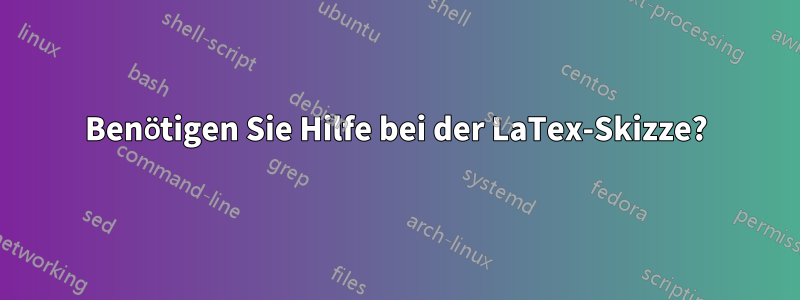
Ich benutze Tikz eine Figur zu zeichnen, die viele Dinge beinhaltet, die ich sicherlich für weitere Figuren brauchen werde. Es wäre toll, wenn mir jemand helfen würde! Ich stecke derzeit fest, insbesondere was die Positionierung der Blöcke betrifft ...
Das habe ich bisher, aber ich brauche noch etwas Pfeiltext:
\begin{tikzpicture}
[block/.style={draw,minimum width=#1,minimum height=2em},
block/.default=10em,high/.style={minimum height=3em},node distance=2em]
\node (n0){Start};
\node[block=28em,high,below=of n0] (n1){Identification Goal Definition + Prior Knowledge Accumulation};
\node[block,below=of n1.south west,xshift=2em,anchor=north west] (n2){System Excitation};
\node[block,below=of n2] (n3){Model Architecture Selection};
\node[block,below=of n3] (n4){Order and Parameter Estimation};
\node[block,below=of n4] (n5){Model Validation};
\node[block=25em,high,below=of n5.south west,anchor=north west] (n6){Successful System Identification};
\draw[-stealth] (n0) edge (n1)
foreach \X in {1,...,5} {(n\X.south-|n2) edge (n\the\numexpr\X+1\relax.north-|n2)}
(n5.east) -- ++(5em,0) coordinate (aux) |- (n2);
\draw[-stealth] (aux|-n4) edge (n4) (n5.east) --++ (2em,0);
\draw[-stealth] (aux|-n3) edge (n3) (n5.east) --++ (2em,0);
\end{tikzpicture}
Antwort1
Willkommen! Es gibt ungefähr 100 solcher Diagramme auf dieser Site. Jetzt gibt es noch eins mehr. Um eine korrekte Positionierung zu erreichen, können Sie die positioningBibliothek verwenden. Es gibt viele andere Tools wie, chainsaber in diesem Fall lohnen sie sich meiner Meinung nach nicht.
\documentclass{article}
\usepackage{tikz}
\usetikzlibrary{positioning}
\begin{document}
\begin{tikzpicture}[block/.style={draw,minimum width=#1,minimum height=2em},
block/.default=10em,high/.style={minimum height=3em},node distance=2em]
\node (n0){Start};
\node[block=28em,high,below=of n0] (n1){};
\node[block,below=of n1.south west,xshift=2em,anchor=north west] (n2){};
\node[block,below=of n2] (n3){};
\node[block,below=of n3] (n4){};
\node[block=25em,high,below=of n4.south west,anchor=north west] (n5){};
\draw[-stealth] (n0) edge (n1)
foreach \X in {1,...,4} {(n\X.south-|n2) edge (n\the\numexpr\X+1\relax.north-|n2)}
(n4.east) -- ++(5em,0) coordinate (aux) |- (n2);
\draw[-stealth] (aux|-n3) edge (n3) (n4.east) --++ (2em,0);
\end{tikzpicture}
\end{document}
Um Pfeile hinzuzufügen, können Sie verwenden quotes.
\documentclass{article}
\usepackage{tikz}
\usetikzlibrary{positioning,quotes}
\begin{document}
\begin{tikzpicture}[block/.style={draw,minimum width=#1,minimum height=2em},
block/.default=10em,high/.style={minimum height=3em},node distance=2em,auto]
\node (n0){Start};
\node[block=28em,high,below=of n0] (n1){};
\node[block,below=of n1.south west,xshift=2em,anchor=north west] (n2){};
\node[block,below=of n2] (n3){};
\node[block,below=of n3] (n4){};
\node[block=25em,high,below=of n4.south west,anchor=north west] (n5){};
\draw[-stealth] (n0) edge["a"] (n1)
foreach \X in {1,...,4} {(n\X.south-|n2) edge["b"] (n\the\numexpr\X+1\relax.north-|n2)}
(n4.east) -- ++(5em,0) coordinate (aux) |- node[pos=0.75]{c}(n2);
\draw[-stealth] (aux|-n3) edge["d"] (n3) (n4.east) --node{e}++ (2em,0);
\end{tikzpicture}
\end{document}
Und dies ist der Code Ihrer aktualisierten Frage mit Pfeiltexten.
\documentclass{article}
\usepackage{tikz}
\usetikzlibrary{positioning,quotes}
\begin{document}
\begin{tikzpicture}
[block/.style={draw,minimum width=#1,minimum height=2em},
block/.default=10em,high/.style={minimum height=3em},
node distance=2em,auto]
\node (n0){Start};
\node[block=28em,high,below=of n0] (n1){Identification Goal Definition + Prior Knowledge Accumulation};
\node[block,below=of n1.south west,xshift=2em,anchor=north west] (n2){System Excitation};
\node[block,below=of n2] (n3){Model Architecture Selection};
\node[block,below=of n3] (n4){Order and Parameter Estimation};
\node[block,below=of n4] (n5){Model Validation};
\node[block=25em,high,below=of n5.south west,anchor=north west] (n6){Successful System Identification};
\draw[-stealth] (n0) edge["a"] (n1)
foreach \Y [count=\X] in {bla,blub,pft,ghh,trf}
{(n\X.south-|n2) edge["\Y"] (n\the\numexpr\X+1\relax.north-|n2)}
(n5.east) -- ++(5em,0) coordinate (aux) |- node[pos=0.75] {d} (n2) ;
\draw[-stealth] (aux|-n3) edge["c"] (n3)
(aux|-n4) edge["b"] (n4) (n5.east) -- node[pos=0.5]
{prt} ++ (2em,0);
\end{tikzpicture}
\end{document}
Die Texte sind einzigartig, sodass Sie sie durch alles ersetzen können, was Sie möchten. Bitte stellen Sie sicher, dass Sie die quotesBibliothek (und natürlich ) laden, wenn Sie sie einfach zu Ihrem Dokument positioninghinzufügen .tikzpicture
Antwort2
Eine kleine Variation von @Schrödingers Katzenantwort. Unter Verwendung der chainsBibliothek und des Makros `join:
\documentclass{article}
\usepackage{tikz}
\usetikzlibrary{arrows.meta,
chains,
positioning}
\begin{document}
\begin{tikzpicture}[
node distance = 8mm and 0mm,
start chain = going above,
box/.style = {draw, minimum width=#1, minimum height=12mm, on chain},
box/.default = 44mm,
every join/.style = {<-},
> = {Stealth[length=3mm]}
]
\node (n1) [box=88mm]{};
\node (n2) [box, above right=of n1.north west] {};
\node (n3) [box,join] {};
\node (n4) [box,join] {};
\node (n5) [box=96mm, above right=8mm and -8mm of n4.north west] {};
\draw[<-] (n5.north) -- ++ (0,0.8) node[above] {Start};
%
\begin{scope}[every path/.style={->}]
\draw (n5.south -| n4) -- (n4);
\draw (n2.east) -- ++ (1,0);
\draw (n2.east) ++ (1,0) -- ++ (1,0) |- (n3);
\draw (n3.east) ++ (2,0) |- (n4);
\draw (n2) -- (n2 |- n1.north);
\end{scope}
\end{tikzpicture}
\end{document}








